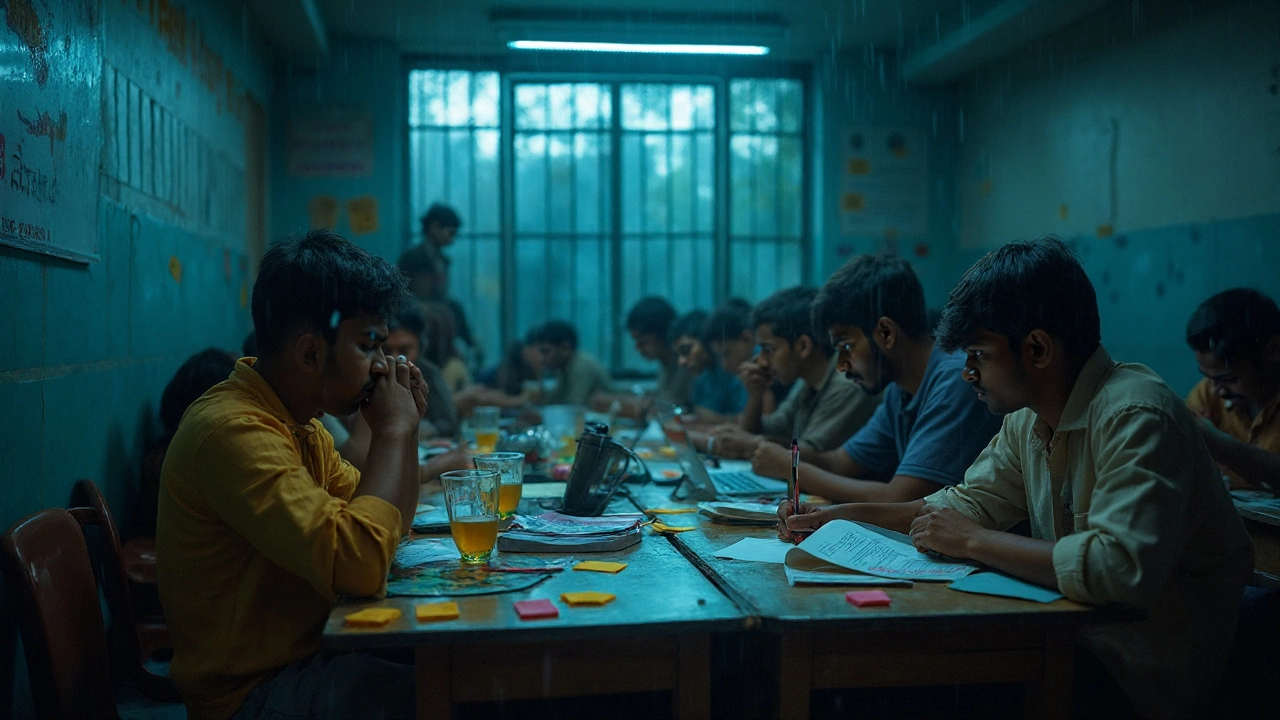You clicked because you want a straight answer, not hand-waving. So here it is: the South Korean College Scholastic Ability Test-Suneung-is the single most stressful high‑stakes exam on the planet. Gaokao in China has bigger scale, UPSC in India has a lower success rate, and JEE Advanced and NEET-UG turn teens into full-time test athletes. But Suneung compresses the pressure into one nationwide day where the country literally slows down for it-flights reroute or pause during the English listening section and police escort late candidates to centres. That one-day, all-or-nothing feeling is hard to beat.
To set expectations: there’s no official stress ruler. Different systems punish in different ways-selectivity, time compression, life consequences, culture. So I’ll name the winner, show the criteria, compare the big exams with fresh data, and give you practical ways to manage that pressure-whether you’re facing Suneung, Gaokao, JEE/NEET, UPSC, USMLE, or the CFA.
- TL;DR: The South Korean Suneung is the most stressful exam because it’s one day, synchronized nationwide, and tied tightly to social mobility; the whole country adjusts to reduce noise.
- Gaokao is the biggest by numbers (13.4M candidates in 2024), but allows more paths and retakes; pressure is massive, but distributed.
- UPSC Civil Services is the most selective by odds (~0.1% final success), yet spread across three stages; it’s a marathon of stress, not a single-day spike.
- JEE Advanced and NEET-UG are brutal pipelines; stress comes from seat scarcity and early specialization.
- Preparation beats panic: build a 12-week cycle, cap daily intensity, rehearse the day, and use low-arousal techniques to avoid cognitive overload.
What counts as “most stressful”? A clear answer and a global comparison
If you’re strict about the definition-worst moment-to-moment stress per candidate-Suneung edges the field. It happens once per year, the timing is synchronized to the minute across the country, and the stakes are concentrated into a single sitting that essentially sorts university access and, by extension, career options in a very status-conscious system. South Korea’s Ministry of Land and Transport coordinates with aviation so planes don’t disrupt the English listening segment; local police routinely escort late students on test morning; businesses open late to ease traffic. You don’t get that degree of national choreography around any other exam.
Why pick Suneung over China’s Gaokao? Gaokao is enormous-about 13.42 million candidates sat in 2024 (China’s Ministry of Education). It lasts multiple days and has deep consequences for university placement. But the stress is spread across papers and provinces, and there are multiple tracks and retake options. By contrast, Suneung concentrates pressure into a single day and is tightly linked to entry into a handful of ultra-prestigious SKY universities (Seoul National, Korea, Yonsei), which still carry outsized weight in hiring.
Why not UPSC, which has nastier odds? The Indian Civil Services Exam draws over a million applicants and final posts often hover near a thousand (Union Public Service Commission annual reports). That’s a success rate around a tenth of a percent. Horrific odds-yet the stress is staged: Preliminary (MCQ), Mains (essay-heavy), and interview, spread across many months. People can regroup between stages, which diffuses the acute, within-day panic.
JEE Advanced and NEET-UG deserve a special mention. JEE Advanced is a sophisticated, concept-heavy paper reserved for those who clear JEE Main. Seats in the IITs are limited (roughly 17-18k). The pipeline feels like a pressure cooker because students often start intense prep years earlier. NEET-UG is even bigger by registrations (over 2 million in 2024 per the National Testing Agency), and controversy about fairness and leaks can raise anxiety. But again, not a single synchronized national slow-down day that silences planes.
To keep this honest, here’s a simple scoring framework you can use to judge any exam:
- Stakes: How directly does the result gate life outcomes in that system?
- Time compression: Is it one day or many? Are retakes frequent?
- Selectivity: Seats vs candidates-what are the odds?
- System lock-in: Does the exam route you early into a track, with few lateral options?
- Cultural amplification: Family, media, and employer obsession-does it turn the exam into a rite of passage?
Weight these 20% each, or change the weights for your context. Suneung scores high on all five at once. Gaokao: high on stakes and selectivity, medium on time compression (multi-day, retakes). UPSC: extreme selectivity, moderate time compression (multi-stage). JEE/NEET: high stakes and selectivity, medium time compression.
Fresh comparative yardsticks (2023-2025 estimates and public reports):
| Exam | Country/Region | Scale (latest) | Format & Duration | Retake/Frequency | Key Bottleneck | Stress Index (1-10) |
|---|---|---|---|---|---|---|
| Suneung (CSAT) | South Korea | ~500k candidates/year | One synchronized day, ~8+ hours, multiple sections incl. high-stakes English listening | Once a year; retake next year | Single-day, culturally amplified stakes; national quiet measures | 9.5 |
| Gaokao | China | 13.42M in 2024 (MOE) | 2-4 days, province-specific papers | Annual; retakes allowed | Scale and sorting into tiers of universities | 9.0 |
| JEE Advanced (via JEE Main) | India | ~1.4M JEE Main; ~180k sit Advanced | Concept-heavy papers in one day (often two sessions) | Annual; limited seats ~18k | Low seat ratio; early specialization | 8.8 |
| NEET-UG | India | >2M in 2024 (NTA) | Single-day, pen-and-paper MCQ | Annual | Seat scarcity; career lock-in to medicine | 8.6 |
| UPSC Civil Services | India | ~1M+ applicants; ~1k final posts | Prelims (MCQ), Mains (essay), Interview over months | Annual | Brutal selectivity across stages | 8.4 |
| USMLE Step 2 CK | USA (global candidates) | Tens of thousands yearly | 9+ hour computer exam; Step 1 now pass/fail | Multiple annual windows | Residency placement pressure | 7.6 |
| CFA (Level I-III) | Global | Hundreds of thousands across levels | Computer-based; full-day stamina needed | Multiple windows each year | Low pass rates; working adults balancing jobs | 7.2 |
| Bar Exam (e.g., UBE) | USA | Varies by state | 2 days; essays + MBE | Biannual | Job offers often hinge on pass | 7.0 |
| YKS | Turkey | ~3M+ | Multi-session weekend | Annual | Seat pressure into top faculties | 8.0 |
| Konkur (reformed) | Iran | ~1M historically | High-stakes single sitting (reforms ongoing) | Retake reforms introduced | University tracking | 8.2 |
A few context notes so the numbers mean something:
- South Korea’s plane and traffic adjustments for Suneung’s English listening are documented annually by government notices and national media (e.g., 2023-2024 briefings by the Ministry of Education and transport authorities).
- China’s Gaokao count (13.42M in 2024) is from the Ministry of Education and state media tallies.
- NEET-UG and JEE volumes are from the National Testing Agency summaries; seat counts vary by year and category.
- UPSC success rates are computed from annual exam stats (notified vacancies vs. applicants).
- USMLE stress shifted after Step 1 became pass/fail in 2022; Step 2 CK now carries more weight (NBME and FSMB reports show pass rates around the mid-90s for US grads, lower for IMGs).
If you’re in the UK like me, A‑levels feel huge-and they are. But compared with Suneung or Gaokao, there’s more modularity, resits, and alternative pathways. Stress is real; terminal, all-or-nothing pressure is rarer.

How to prepare for extreme‑stakes exams without burning out
I’m not going to pretend there’s a magic plan. There is, however, a set of routines that cut anxiety and raise output. Use these like a menu, not a script.
Start with this rule of thumb: intensity beats hours until it doesn’t. More than ~6 hours of real, focused study per day tends to give you worse recall the next morning. A 2021 sleep and learning review in Nature and Science of Sleep found that consolidated sleep and spaced retrieval predict performance better than raw time on task. Quality, not martyrdom.
- Build a 12‑week cycle that repeats. Weeks 1-8: learn and interleave. Week 9: full-length mocks. Week 10: fix weak topics. Week 11: second pass mocks. Week 12: taper and sleep. For Suneung, Gaokao, JEE, and NEET, this rhythm balances coverage and stamina.
- Use active recall and spaced repetition. Short, daily Q&A cards beat rereading. If you can’t explain a topic out loud in 60 seconds, you don’t own it.
- Interleave subjects. Don’t cram one subject for three straight days; mix two or three domains per day. Interleaving improves discrimination and transfer.
- Run biweekly “exam rehearsals.” Simulate the clock, breaks, watch rules, calculator settings, the lot. The brain calms down when the environment feels familiar.
- Write a one‑page “If‑Then” plan for test day. “If my mind blanks, then I breathe 4‑4‑6 for three cycles; if I lose time, then I skip to the next item and mark it.” This lowers panic when things wobble.
- Protect sleep like it’s part of the syllabus. 7-9 hours. Last three nights matter more than the last three chapters.
- Use low‑arousal routines. 10-minute walks, box breathing (4 in, 4 hold, 6 out), progressive muscle relaxation. Tiny, boring habits beat last-minute heroics.
- Keep a “miss log,” not a shame diary. For every mistake, write: what I thought, what the right move was, and one cue to catch it next time.
Day-of tactics that actually work:
- Early arrival buffer: 45-60 minutes. For Suneung/CSAT, check transport advisories; in Korea, police help latecomers but don’t bank on it.
- Fuel and fluids: light breakfast, steady carb + protein. No experiment foods. Caffeine normal dose, not double.
- Pacing wedges: divide each section into thirds. At one‑third time, be at one‑third questions. If behind, skip and bank easier marks.
- Reset ritual between sections: stand, shoulder roll, slow exhale. Give the nervous system a cue that one block is done, the next begins clean.
- Micro‑checklist before bubbling/typing: name, ID, booklet code, calculator mode, time sync. Prevent dumb losses.
Signs your stress strategy needs a reset:
- You’re “studying” 9-10 hours but forgetting next day. Cut to 5-6 focused hours; add spaced recall.
- You can do question banks but freeze on mocks. Increase full-length simulations; reduce passive review.
- Your sleep is wrecked. Stop study 90 minutes before bed, no screens last 30 minutes, same wake time daily.
- You’re ruminating. Set a 15‑minute “worry window” after lunch to write down fears and solutions. Outside that, parking-lot the thought.
If you’re a parent or partner trying to help, two things actually move the needle: reduce micro‑stressors (transport, meals, printing, stationery) and praise effort quality, not just outcomes. A 2017 OECD student well‑being survey flagged performance pressure and fear of failure as top drivers of school stress. Your job: make the environment safer, not louder.
For working adults (CFA, bar, professional licensure), constrain study to the same time block daily-consistency beats heroic weekends. Protect one non‑negotiable hour of exercise weekly; cardiovascular fitness reduces perceived effort and improves executive function under stress.

Common questions and practical next steps
Mini‑FAQ
- Is “most stressful” the same as “hardest”? Not really. Hardest can mean most conceptually challenging (think JEE Advanced problem solving or some Olympiad qualifiers). Most stressful is about the pressure profile: stakes, time compression, culture, and consequences. Suneung wins on pressure density.
- Which exam has the lowest odds? UPSC Civil Services sits near the floor on odds (around 0.1% final selection). But the stress is spread out across stages and attempts.
- What about medical licensing? USMLE Step 2 CK is now the stress focal point for US medical grads since Step 1 went pass/fail. For international grads, both Steps carry immigration and residency stakes, which adds stress beyond the test content.
- Is Gaokao more humane now? Some provinces have reformed paper structures and there’s wider university expansion compared with the 1990s. But at 13 million plus candidates, placement pressure remains heavy.
- Are leaks and controversies part of the stress? Yes. Doubt about fairness amplifies anxiety because it steals the sense of control. The practical response is to control what you can: mocks, routines, rest, paperwork, and backup plans.
Checklists you can use today
- One‑page exam dossier: ID, admit card, candidate number, centre address and map, travel plan A/B, allowed items list, timed section plan.
- Week plan: 3 priority topics + 2 mocks + 1 full rest day.
- Miss log format: question ID → error type (concept, process, careless) → new cue.
- Pre‑sleep wind‑down: dim light, warm shower, 10 minutes of a paper book, no phone.
A simple decision guide for where to put your energy
- If your exam is single‑day, single‑sitting (Suneung, NEET, many bar exams): train pacing, endurance, and reset rituals. Do more full-length simulations than you think.
- If multi‑stage (UPSC, medical boards, some language proficiencies): plan recovery blocks after each stage; don’t carry Stage 1 habits blindly into Stage 2.
- If concept‑intensive (JEE Advanced): bias toward problem sets that force transfers across topics; build a “toolbox page” you rewrite weekly with tactics.
- If memory‑heavy (Gaokao humanities, medicine pre‑clinicals): use spaced repetition with images and mnemonics; test yourself forward and backward.
Next steps by persona
- Suneung candidate: Lock transport and timing now. Run two full dress rehearsals at the exact start time. Practice English listening with mild background noise so the real silence feels easy.
- Gaokao candidate: Treat the exam as a series of sprints. Build subject rotation: STEM in the morning, humanities later. Weekly provincial‑style mocks to match your paper type.
- JEE/NEET aspirant: Do a weekly cumulative test where old topics reappear. That’s how you beat the forgetting curve while also raising your rank in the middle of the paper.
- UPSC candidate: Write daily-250 words, timed-on a current topic. The essay muscle is perishable. After prelims, shift to structured note compression.
- USMLE/CFA/Bar: Create a constraints calendar: work hours, family, sleep. Your success lives in what you protect, not what you promise.
Pitfalls to avoid
- Endless note‑making without retrieval. If you don’t test yourself, your brain assumes storage isn’t required.
- Peak week overload. You won’t learn a new topic on the last night; you will wreck your sleep.
- Ignoring paperwork. A missing ID or a banned calculator can cost you more marks than any single weak topic.
- Comparing raw hours. Bragging rights don’t convert into scores; error rates and recall do.
If you want a compact formula for stress management, use this: Stress you feel = Perceived demands − Perceived control. You can’t always change the demands of Suneung or Gaokao. You can raise control-through rehearsal, routines, checklists, and support. Every extra bit of control you build reduces the gap.
Sources worth knowing, if you want to dig deeper: China’s Ministry of Education yearbooks (for Gaokao totals), South Korea’s Ministry of Education and transport notices around Suneung day logistics, National Testing Agency exam statistics (NEET/JEE), UPSC annual reports, NBME/FSMB performance data (USMLE), and CFA Institute pass rate reports. Health-wise, the OECD 2017 student well‑being survey is a good primer on pressure and fear of failure, and there are solid sleep-and-learning reviews in journals like Nature and Science of Sleep. No need to read them all; just know the signal: smart routines beat brute force.
Quick wrap-up goals for this week:
- Pick two days for full mocks at the real time of day.
- Trim your daily study to 5-6 focused hours plus 60-90 minutes of recall and review.
- Make your one‑page If‑Then plan and your exam dossier. Print them.
- Book transport and scout your centre if you can. Remove unknowns; the mind relaxes.
- Schedule one device‑free hour before bed, every night until test day.
